engine Alfa Romeo 4C 2014 Owner handbook (in English)
[x] Cancel search | Manufacturer: ALFA ROMEO, Model Year: 2014, Model line: 4C, Model: Alfa Romeo 4C 2014Pages: 190, PDF Size: 7.87 MB
Page 32 of 190

Move the stalk upwards (unstable
position) to limit operation to the time
for which the stalk is held manually
in this position. When released, the
stalk will return to its initial position and
the screen wiper will be stopped
automatically.
With ring nut A fig. 23 in
position,
the screen wiper will automatically
adapt its operating speed to the speed
of the car.
"Smart washing"
function
Pull the stalk towards the steering
wheel (unstable position) to operate the
screen washer. Keeping the stalk pulled
for more than half a second, with just
one movement it is possible to operate
the screen washer jet and the wiper
at the same time.
The wiper stops working three strokes
after the stalk is released. A further
stroke after approximately 6 seconds
completes the cycle.
WARNING
12) Do not use the screen wiper to
remove layers of snow or ice
from the windscreen. In such
conditions, the screen wiper may
be subjected to excessive stress
and the motor cut-out switch,
which prevents operation for
a few seconds, may intervene. If
operation is not subsequently
restored (even after using the key
to restart the engine), contact
the dedicated Alfa Romeo
Dealership.
13) Do not operate the screen wiper with the blades lifted from the
windscreen.
CRUISE CONTROL(for versions/markets, where provided)
IN BRIEF
This is an electronically controlled
driving assistance device that allows
the desired car speed to be
maintained, without having to press
the accelerator pedal. This device
can be used at a speed above
30 km/h on long stretches of dry,
straight roads with few variations
(e.g. motorways).
It is therefore not recommended to
use this device on extra-urban roads
with traffic. Do not use it in town.
Activation
Turn ring nut A fig. 24 to
.
24
A0L0022
29
24-9-2013 11:49 Pagina 29
Page 33 of 190

The device cannot be engaged in 1st or
reverse gear: it is advisable to engage
it in 5th gear or higher.
When travelling downhill with the device
engaged, the car may slightly exceed
the stored speed.
When the device is activated, the
digital warning light switches on
together with the relevant message on
the display.
Storing speed
Proceed as follows:
❒ turn ring nut A fig. 24 to
and
press the accelerator to reach the
desired speed;
❒ move the stalk upwards (+) for at
least 1 second, then release it: the
car speed is now stored and you can
therefore release the accelerator.
If needed (when overtaking for
instance), you can accelerate simply by
pressing the accelerator; when you
release the pedal, the car goes back to
the speed stored previously. Restoring speed
If the device has been deactivated, for
example by pressing the brake pedal,
the stored speed can be restored as
follows:
❒
accelerate gradually until a speed
approaching the one stored is
reached;
❒ engage the gear selected at the time
that the speed was stored;
❒ press the CANCEL/RESUME button
(B fig. 24).
Increasing speed
This can be done in two ways:
❒ by pressing the accelerator and
storing the new speed reached
or
❒ by moving the stalk upwards (+) until
the new speed, which will be stored
automatically, is reached.
Each movement of the stalk
corresponds to an increase in speed of
about 1 km/h, while keeping the stalk
held upwards will continuously increase
the speed. Decreasing speed
This can be done in two ways:
❒
by deactivating the device and then
storing the new speed
or
❒ by moving the stalk downwards (–)
until the new speed, which will be
stored automatically, is reached.
Each movement of the stalk will
correspond to a slight reduction in
speed of about 1 km/h, while keeping
the stalk held downwards will decrease
the speed continuously.
Deactivation
The device can be switched off by the
driver in the following ways:
❒ by turning ring nut A fig. 24 to O;
❒ by switching off the engine;
❒ by pressing the CANCEL/RESUME
button;
❒ by pressing the brake pedal or the
accelerator; in this last case the
system is not completely deactivated
but gives priority to the acceleration
request. The device still remains
active, without the need to press the
CANCEL/RESUME button to return
to the previous condition once
acceleration is concluded.
30
GETTING TO KNOW YOUR CAR
24-9-2013 11:49 Pagina 30
Page 34 of 190
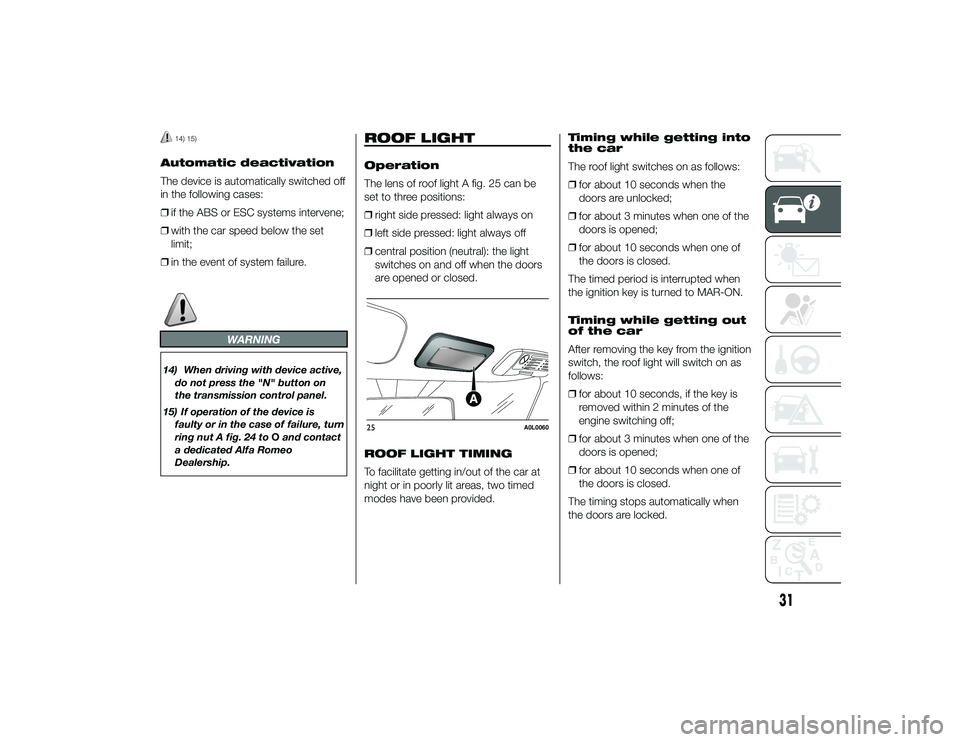
14) 15)
Automatic deactivation
The device is automatically switched off
in the following cases:
❒if the ABS or ESC systems intervene;
❒ with the car speed below the set
limit;
❒ in the event of system failure.
WARNING
14) When driving with device active,
do not press the "N" button on
the transmission control panel.
15) If operation of the device is faulty or in the case of failure, turn
ring nut A fig. 24 to Oand contact
a dedicated Alfa Romeo
Dealership.
ROOF LIGHTOperation
The lens of roof light A fig. 25 can be
set to three positions:
❒ right side pressed: light always on
❒ left side pressed: light always off
❒ central position (neutral): the light
switches on and off when the doors
are opened or closed.
ROOF LIGHT TIMING
To facilitate getting in/out of the car at
night or in poorly lit areas, two timed
modes have been provided. Timing while getting into
the car
The roof light switches on as follows:
❒
for about 10 seconds when the
doors are unlocked;
❒ for about 3 minutes when one of the
doors is opened;
❒ for about 10 seconds when one of
the doors is closed.
The timed period is interrupted when
the ignition key is turned to MAR-ON.
Timing while getting out
of the car
After removing the key from the ignition
switch, the roof light will switch on as
follows:
❒ for about 10 seconds, if the key is
removed within 2 minutes of the
engine switching off;
❒ for about 3 minutes when one of the
doors is opened;
❒ for about 10 seconds when one of
the doors is closed.
The timing stops automatically when
the doors are locked.25
A0L0060
31
24-9-2013 11:49 Pagina 31
Page 35 of 190
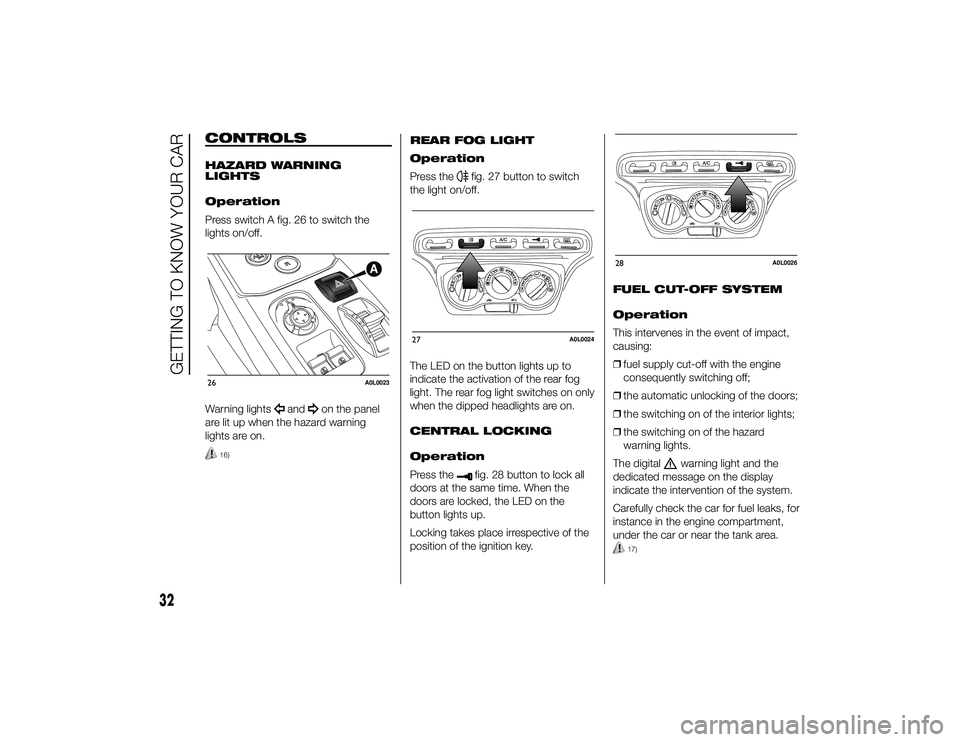
CONTROLSHAZARD WARNING
LIGHTS
Operation
Press switch A fig. 26 to switch the
lights on/off.
Warning lights
and
on the panel
are lit up when the hazard warning
lights are on.
16)
REAR FOG LIGHT
Operation
Press the
fig. 27 button to switch
the light on/off.
The LED on the button lights up to
indicate the activation of the rear fog
light. The rear fog light switches on only
when the dipped headlights are on.
CENTRAL LOCKING
Operation
Press thefig. 28 button to lock all
doors at the same time. When the
doors are locked, the LED on the
button lights up.
Locking takes place irrespective of the
position of the ignition key. FUEL CUT-OFF SYSTEM
Operation
This intervenes in the event of impact,
causing:
❒
fuel supply cut-off with the engine
consequently switching off;
❒ the automatic unlocking of the doors;
❒ the switching on of the interior lights;
❒ the switching on of the hazard
warning lights.
The digital
warning light and the
dedicated message on the display
indicate the intervention of the system.
Carefully check the car for fuel leaks, for
instance in the engine compartment,
under the car or near the tank area.
17)
26
A0L0023
27
A0L0024
28
A0L0026
32
GETTING TO KNOW YOUR CAR
24-9-2013 11:49 Pagina 32
Page 42 of 190
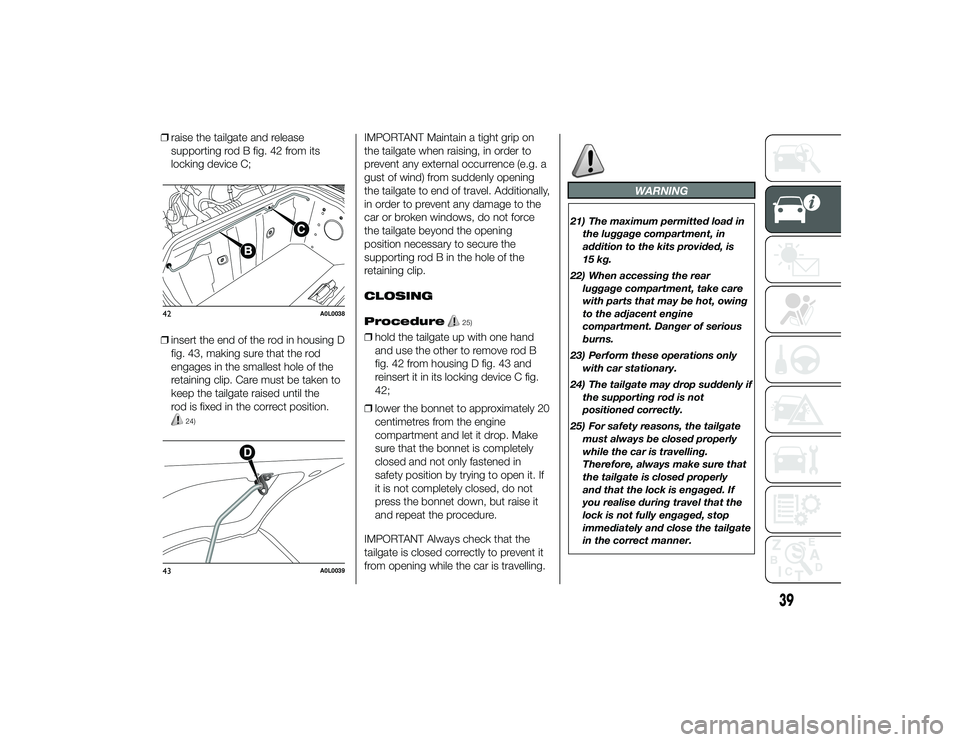
❒raise the tailgate and release
supporting rod B fig. 42 from its
locking device C;
❒ insert the end of the rod in housing D
fig. 43, making sure that the rod
engages in the smallest hole of the
retaining clip. Care must be taken to
keep the tailgate raised until the
rod is fixed in the correct position.
24)
IMPORTANT Maintain a tight grip on
the tailgate when raising, in order to
prevent any external occurrence (e.g. a
gust of wind) from suddenly opening
the tailgate to end of travel. Additionally,
in order to prevent any damage to the
car or broken windows, do not force
the tailgate beyond the opening
position necessary to secure the
supporting rod B in the hole of the
retaining clip.
CLOSING
Procedure
25)
❒hold the tailgate up with one hand
and use the other to remove rod B
fig. 42 from housing D fig. 43 and
reinsert it in its locking device C fig.
42;
❒ lower the bonnet to approximately 20
centimetres from the engine
compartment and let it drop. Make
sure that the bonnet is completely
closed and not only fastened in
safety position by trying to open it. If
it is not completely closed, do not
press the bonnet down, but raise it
and repeat the procedure.
IMPORTANT Always check that the
tailgate is closed correctly to prevent it
from opening while the car is travelling.
WARNING
21) The maximum permitted load in the luggage compartment, in
addition to the kits provided, is
15 kg.
22) When accessing the rear luggage compartment, take care
with parts that may be hot, owing
to the adjacent engine
compartment. Danger of serious
burns.
23) Perform these operations only with car stationary.
24) The tailgate may drop suddenly if the supporting rod is not
positioned correctly.
25) For safety reasons, the tailgate must always be closed properly
while the car is travelling.
Therefore, always make sure that
the tailgate is closed properly
and that the lock is engaged. If
you realise during travel that the
lock is not fully engaged, stop
immediately and close the tailgate
in the correct manner.
42
A0L0038
43
A0L0039
39
24-9-2013 11:49 Pagina 39
Page 44 of 190
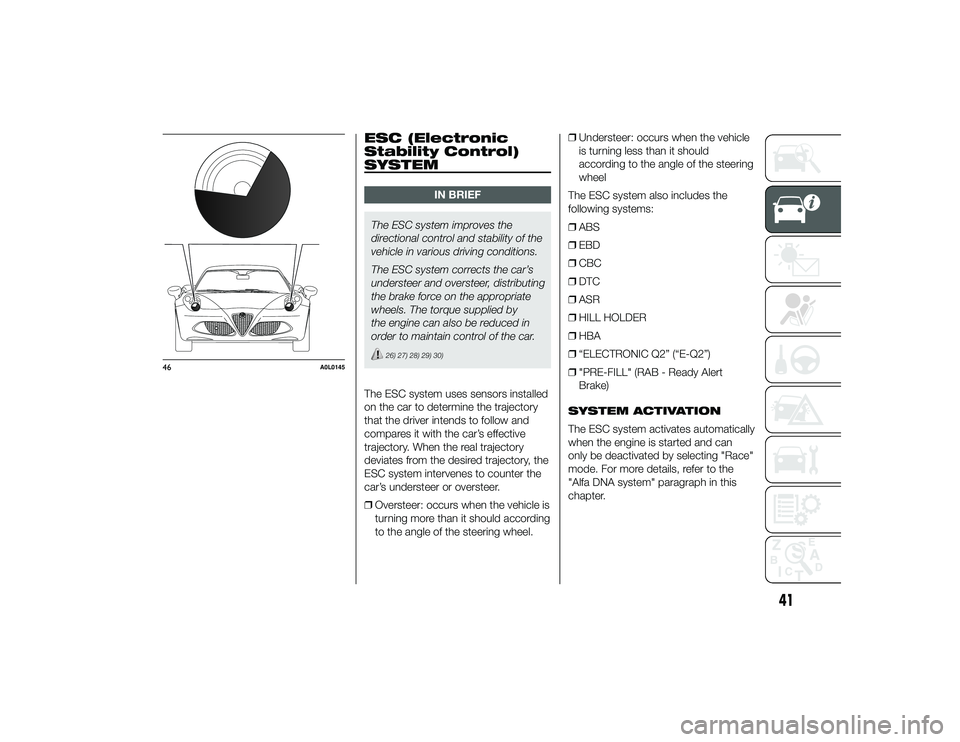
ESC (Electronic
Stability Control)
SYSTEM
IN BRIEF
The ESC system improves the
directional control and stability of the
vehicle in various driving conditions.
The ESC system corrects the car’s
understeer and oversteer, distributing
the brake force on the appropriate
wheels. The torque supplied by
the engine can also be reduced in
order to maintain control of the car.
26) 27) 28) 29) 30)
The ESC system uses sensors installed
on the car to determine the trajectory
that the driver intends to follow and
compares it with the car’s effective
trajectory. When the real trajectory
deviates from the desired trajectory, the
ESC system intervenes to counter the
car’s understeer or oversteer.
❒ Oversteer: occurs when the vehicle is
turning more than it should according
to the angle of the steering wheel. ❒
Understeer: occurs when the vehicle
is turning less than it should
according to the angle of the steering
wheel
The ESC system also includes the
following systems:
❒ ABS
❒ EBD
❒ CBC
❒ DTC
❒ ASR
❒ HILL HOLDER
❒ HBA
❒ “ELECTRONIC Q2” (“E-Q2”)
❒ "PRE-FILL" (RAB - Ready Alert
Brake)
SYSTEM ACTIVATION
The ESC system activates automatically
when the engine is started and can
only be deactivated by selecting "Race"
mode. For more details, refer to the
"Alfa DNA system" paragraph in this
chapter.
46
A0L0145
41
24-9-2013 11:49 Pagina 41
Page 45 of 190
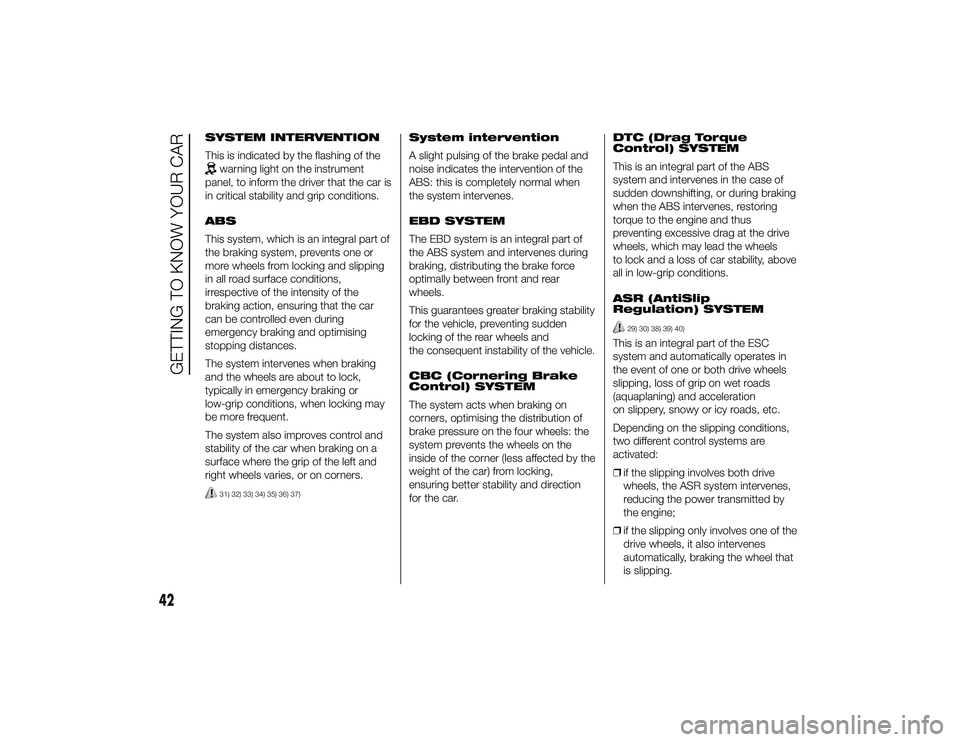
SYSTEM INTERVENTION
This is indicated by the flashing of the
warning light on the instrument
panel, to inform the driver that the car is
in critical stability and grip conditions.
ABS
This system, which is an integral part of
the braking system, prevents one or
more wheels from locking and slipping
in all road surface conditions,
irrespective of the intensity of the
braking action, ensuring that the car
can be controlled even during
emergency braking and optimising
stopping distances.
The system intervenes when braking
and the wheels are about to lock,
typically in emergency braking or
low-grip conditions, when locking may
be more frequent.
The system also improves control and
stability of the car when braking on a
surface where the grip of the left and
right wheels varies, or on corners.31) 32) 33) 34) 35) 36) 37)
System intervention
A slight pulsing of the brake pedal and
noise indicates the intervention of the
ABS: this is completely normal when
the system intervenes.
EBD SYSTEM
The EBD system is an integral part of
the ABS system and intervenes during
braking, distributing the brake force
optimally between front and rear
wheels.
This guarantees greater braking stability
for the vehicle, preventing sudden
locking of the rear wheels and
the consequent instability of the vehicle.
CBC (Cornering Brake
Control) SYSTEM
The system acts when braking on
corners, optimising the distribution of
brake pressure on the four wheels: the
system prevents the wheels on the
inside of the corner (less affected by the
weight of the car) from locking,
ensuring better stability and direction
for the car. DTC (Drag Torque
Control) SYSTEM
This is an integral part of the ABS
system and intervenes in the case of
sudden downshifting, or during braking
when the ABS intervenes, restoring
torque to the engine and thus
preventing excessive drag at the drive
wheels, which may lead the wheels
to lock and a loss of car stability, above
all in low-grip conditions.
ASR (AntiSlip
Regulation) SYSTEM
29) 30) 38) 39) 40)
This is an integral part of the ESC
system and automatically operates in
the event of one or both drive wheels
slipping, loss of grip on wet roads
(aquaplaning) and acceleration
on slippery, snowy or icy roads, etc.
Depending on the slipping conditions,
two different control systems are
activated:
❒
if the slipping involves both drive
wheels, the ASR system intervenes,
reducing the power transmitted by
the engine;
❒ if the slipping only involves one of the
drive wheels, it also intervenes
automatically, braking the wheel that
is slipping.
42
GETTING TO KNOW YOUR CAR
24-9-2013 11:49 Pagina 42
Page 46 of 190
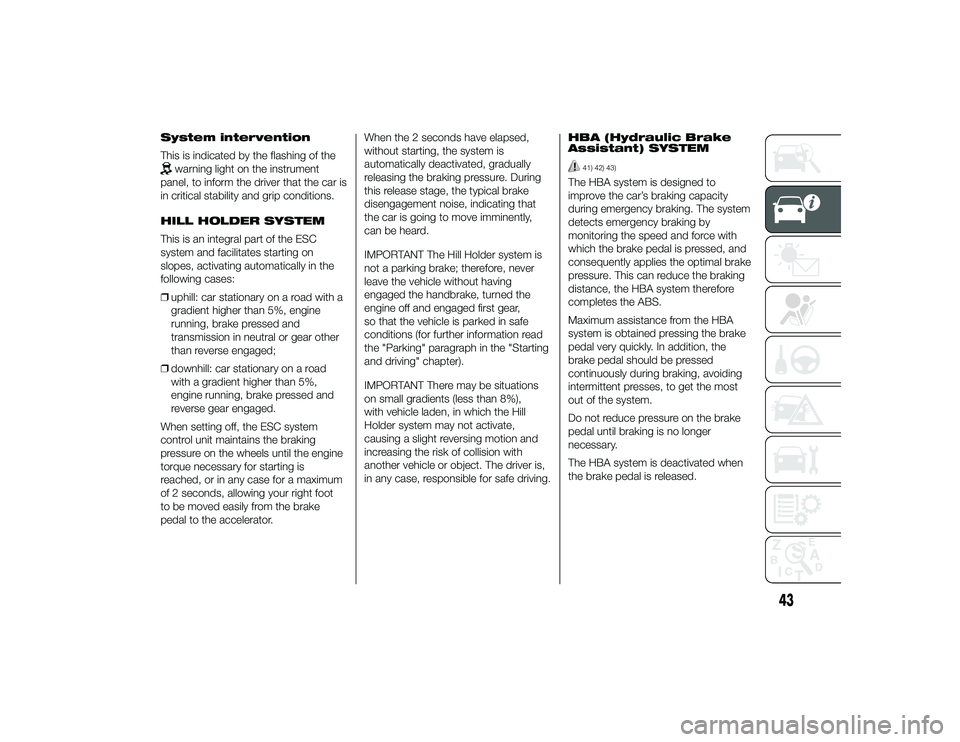
System intervention
This is indicated by the flashing of the
warning light on the instrument
panel, to inform the driver that the car is
in critical stability and grip conditions.
HILL HOLDER SYSTEM
This is an integral part of the ESC
system and facilitates starting on
slopes, activating automatically in the
following cases:
❒ uphill: car stationary on a road with a
gradient higher than 5%, engine
running, brake pressed and
transmission in neutral or gear other
than reverse engaged;
❒ downhill: car stationary on a road
with a gradient higher than 5%,
engine running, brake pressed and
reverse gear engaged.
When setting off, the ESC system
control unit maintains the braking
pressure on the wheels until the engine
torque necessary for starting is
reached, or in any case for a maximum
of 2 seconds, allowing your right foot
to be moved easily from the brake
pedal to the accelerator. When the 2 seconds have elapsed,
without starting, the system is
automatically deactivated, gradually
releasing the braking pressure. During
this release stage, the typical brake
disengagement noise, indicating that
the car is going to move imminently,
can be heard.
IMPORTANT The Hill Holder system is
not a parking brake; therefore, never
leave the vehicle without having
engaged the handbrake, turned the
engine off and engaged first gear,
so that the vehicle is parked in safe
conditions (for further information read
the "Parking" paragraph in the "Starting
and driving" chapter).
IMPORTANT There may be situations
on small gradients (less than 8%),
with vehicle laden, in which the Hill
Holder system may not activate,
causing a slight reversing motion and
increasing the risk of collision with
another vehicle or object. The driver is,
in any case, responsible for safe driving.
HBA (Hydraulic Brake
Assistant) SYSTEM
41) 42) 43)
The HBA system is designed to
improve the car’s braking capacity
during emergency braking. The system
detects emergency braking by
monitoring the speed and force with
which the brake pedal is pressed, and
consequently applies the optimal brake
pressure. This can reduce the braking
distance, the HBA system therefore
completes the ABS.
Maximum assistance from the HBA
system is obtained pressing the brake
pedal very quickly. In addition, the
brake pedal should be pressed
continuously during braking, avoiding
intermittent presses, to get the most
out of the system.
Do not reduce pressure on the brake
pedal until braking is no longer
necessary.
The HBA system is deactivated when
the brake pedal is released.
43
24-9-2013 11:49 Pagina 43
Page 48 of 190
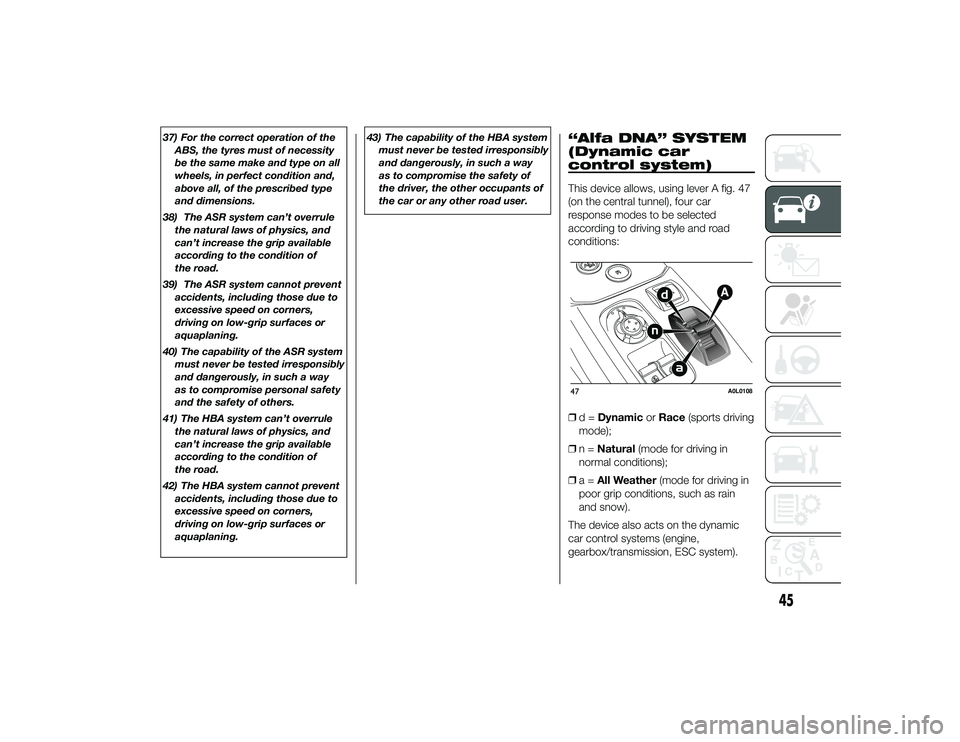
37) For the correct operation of theABS, the tyres must of necessity
be the same make and type on all
wheels, in perfect condition and,
above all, of the prescribed type
and dimensions.
38) The ASR system can’t overrule the natural laws of physics, and
can’t increase the grip available
according to the condition of
the road.
39) The ASR system cannot prevent accidents, including those due to
excessive speed on corners,
driving on low-grip surfaces or
aquaplaning.
40) The capability of the ASR system must never be tested irresponsibly
and dangerously, in such a way
as to compromise personal safety
and the safety of others.
41) The HBA system can’t overrule the natural laws of physics, and
can’t increase the grip available
according to the condition of
the road.
42) The HBA system cannot prevent accidents, including those due to
excessive speed on corners,
driving on low-grip surfaces or
aquaplaning. 43) The capability of the HBA system
must never be tested irresponsibly
and dangerously, in such a way
as to compromise the safety of
the driver, the other occupants of
the car or any other road user.
“Alfa DNA” SYSTEM
(Dynamic car
control system)This device allows, using lever A fig. 47
(on the central tunnel), four car
response modes to be selected
according to driving style and road
conditions:
❒d=Dynamic orRace (sports driving
mode);
❒ n=Natural (mode for driving in
normal conditions);
❒ a=All Weather (mode for driving in
poor grip conditions, such as rain
and snow).
The device also acts on the dynamic
car control systems (engine,
gearbox/transmission, ESC system).47
A0L0108
45
24-9-2013 11:49 Pagina 45
Page 49 of 190
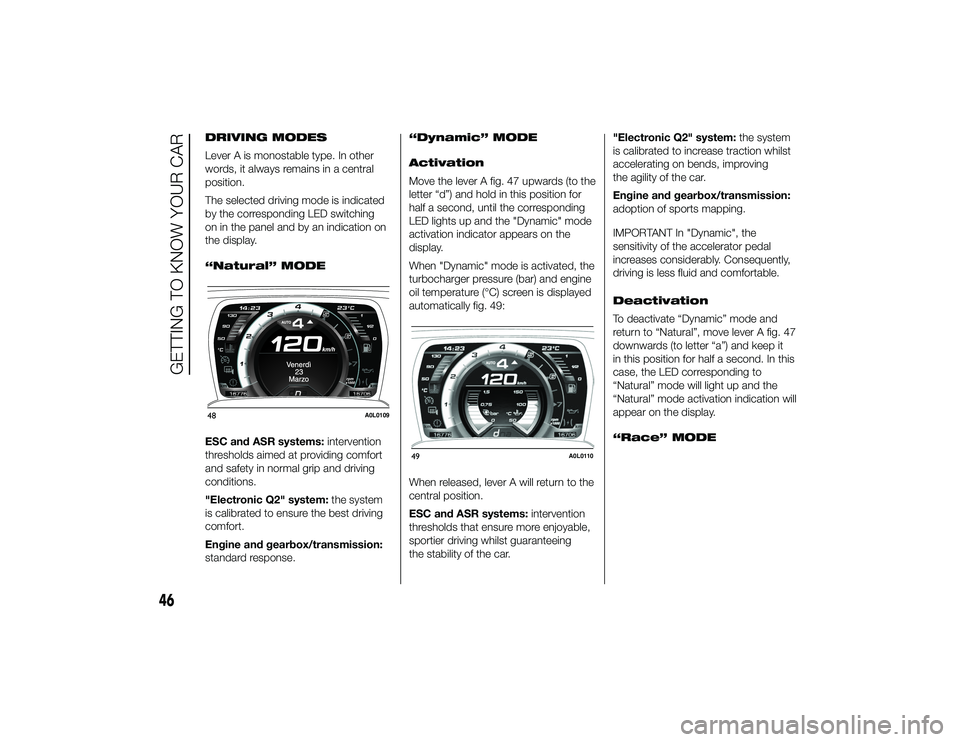
DRIVING MODES
Lever A is monostable type. In other
words, it always remains in a central
position.
The selected driving mode is indicated
by the corresponding LED switching
on in the panel and by an indication on
the display.
“Natural” MODE
ESC and ASR systems:intervention
thresholds aimed at providing comfort
and safety in normal grip and driving
conditions.
"Electronic Q2" system: the system
is calibrated to ensure the best driving
comfort.
Engine and gearbox/transmission:
standard response. “Dynamic” MODE
Activation
Move the lever A fig. 47 upwards (to the
letter “d”) and hold in this position for
half a second, until the corresponding
LED lights up and the "Dynamic" mode
activation indicator appears on the
display.
When "Dynamic" mode is activated, the
turbocharger pressure (bar) and engine
oil temperature (°C) screen is displayed
automatically fig. 49:
When released, lever A will return to the
central position.
ESC and ASR systems:
intervention
thresholds that ensure more enjoyable,
sportier driving whilst guaranteeing
the stability of the car. "Electronic Q2" system:
the system
is calibrated to increase traction whilst
accelerating on bends, improving
the agility of the car.
Engine and gearbox/transmission:
adoption of sports mapping.
IMPORTANT In "Dynamic", the
sensitivity of the accelerator pedal
increases considerably. Consequently,
driving is less fluid and comfortable.
Deactivation
To deactivate “Dynamic” mode and
return to “Natural”, move lever A fig. 47
downwards (to letter “a”) and keep it
in this position for half a second. In this
case, the LED corresponding to
“Natural” mode will light up and the
“Natural” mode activation indication will
appear on the display.
“Race” MODE48
A0L0109
49
A0L0110
46
GETTING TO KNOW YOUR CAR
24-9-2013 11:49 Pagina 46